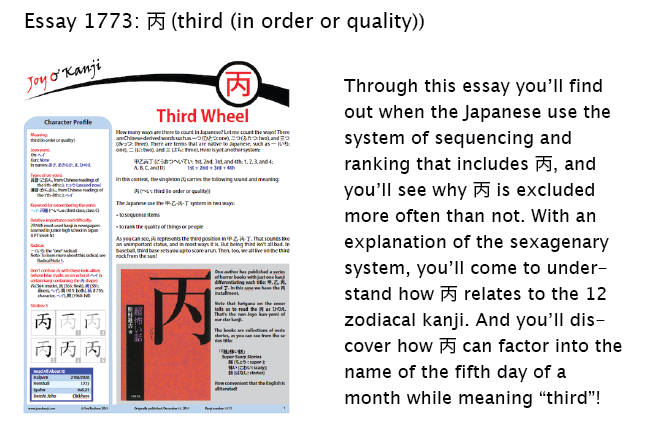Numerical Puns
Let's start with a quiz! If you had to assign a day of the year to be "Happy Husband and Wife Day" or いい夫婦の日 (いいふうふのひ), which day would you choose:
a. February 14
b. March 14
c. July 7
d. November 22
I'll block the answer with a preview of the newest essay, which is actually relevant to the quiz:
The answer is d. November 22. If you render this date as 11.22, you can represent it in kanji as 一一二二. Instead of reading the first two characters as いち, you abbreviate each to い. Finally, working from 二つ (ふたつ: two), you read each 二 as ふ. Thus, you have いいふふ, which is close enough to いいふうふ to work.
So says Japan Times columnist Kaori Shoji in a fun article about numerical puns. That's why I said the new essay is relevant; it has to do with the number three, as well as other numbers.
These bits of her article also jumped out at me:
• The author refers to the 1953 film「にごりえ」 (An Inlet of Muddy Water). I'm thrilled to realize that I've written essays about both kanji in this word:
濁り江 (にごりえ: muddy inlet or creek) mud + inlet
I didn't mention that film in essay 1244 on 江 (bay, cove; river) or in essay 1558 on 濁 (muddiness; impurity; voiced), but the latter contains this passage about a much earlier work:
Though it’s unusual to rave about a brown waterway, someone did write a poem about a muddy inlet long ago:
濁り江の澄まむことこそ難からめいかでほのかに影をだに見む
Just as it is not easy for the muddy inlet to clear up, it is not easy for us to live together. But I will at least somehow see your faint reflection on the water.
澄む (すむ: to clear up); 難し (かたし: difficult); いかで (somehow); ほのかに (仄かに: faintly, a non-Joyo kanji); 影 (かげ: reflection (of a person on the surface of water)); だに (at least); 見る (みる: to see)
This waka (a classic Japanese poem) first appeared in「新古今和歌集 (しんこきんわかしゅう)」, a waka anthology compiled in 1205. A site says that one key to understanding this poem is recognizing that 澄む is homophonous with 住む (すむ: to live) and implies both meanings here.
• Numbers written in kanji, or 漢数字 (かんすうじ), often have roots in Buddhism and are difficult to write, read, and comprehend, says Shoji. I don't know if they're always so difficult to read; certainly that's true of the system called 大字 (だいじ: formal numbers), which includes kanji such as 壱 (one), 弐 (two), and 参 (three). But 漢数字 also includes numbers such as 一, 二, and 三. It can't get much simpler than that! Speaking of simple, the more stripped-down numbers are not simplifications of the more complex ones, as I guessed.
• I like Shoji's anecdote about a girl named Miyako whose parents gave her the kanji rendering 三八子 (3 + 8 + child). The author writes, "Apparently, the girl wasn’t born on March 8, but her parents wanted the number 8 because it symbolizes prosperity and looks like Mount Fuji, smack in the middle of their daughter’s name. The 三 (mi or san, three) was because she was the third child." I have nothing to add to that. I just got a kick out of it, and anytime I get a kick out of kanji, I feel compelled to share the experience with you!
I've done so all year (and this week will mark six years since Joy o' Kanji launched!), so it's time for a break. Happy holidays to all. I'll see you again in the new year!
❖❖❖
Did you like this post? Express your love by supporting Joy o' Kanji on Patreon:



Comments